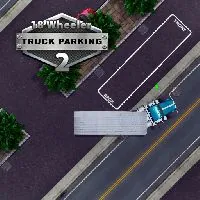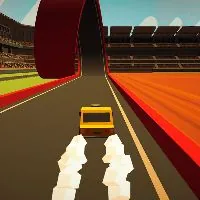CURVY ROAD
SIMILAR GAMES
Description
Curvy Road - GitLab Games
About Curvy Road - GitLab Games
At GitLab Games, we are dedicated to fostering a vibrant and engaging environment for developers to showcase their creativity and problem-solving skills through competitive coding challenges. Our platform is designed to push the boundaries of what's possible, encouraging participants to explore innovative solutions and collaborate on exciting projects. We believe that the future of technology is built on a foundation of shared learning and continuous improvement, and our games are a testament to this philosophy. We strive to create a space where talent is recognized, ingenuity is celebrated, and developer communities thrive.
Understanding the Curvy Road Challenge
The "Curvy Road" challenge represents a cornerstone of our competitive offerings at GitLab Games. This particular challenge is meticulously crafted to test a developer's ability to navigate complex geometrical paths and implement efficient pathfinding algorithms. Participants are tasked with developing solutions that can accurately and swiftly plot a course along a series of predefined curves, often encountering obstacles and dynamic environmental factors. The core of the challenge lies in the precision of calculation and the adaptability of the algorithms employed. We are looking for elegant solutions that can handle intricate curves, varying speeds, and potential deviations with minimal error. The emphasis is on robustness and accuracy, ensuring that the generated path is not only feasible but also optimal under the given constraints. This involves a deep understanding of mathematical principles, computational geometry, and algorithmic design.
Key Objectives of the Curvy Road Challenge
The primary objective of the Curvy Road challenge is to assess and develop a participant's proficiency in several critical areas of software development. We aim to gauge their ability to translate abstract geometrical problems into concrete code. This involves understanding how to represent curves mathematically, such as through Bezier curves or spline interpolations, and then devising algorithms to traverse these curves efficiently. Furthermore, the challenge emphasizes the importance of real-time processing and optimization. In many scenarios, the path must be calculated and adjusted dynamically, requiring solutions that can perform computations with high speed and low latency. Error handling and robustness are also paramount. Unexpected terrain changes, sensor inaccuracies, or minor computational drift can significantly impact the outcome, so participants must build systems that can gracefully handle imperfections and maintain a stable trajectory. Finally, we encourage the exploration of predictive modeling and adaptive control, where participants can anticipate future path segments and adjust their approach accordingly, showcasing a truly advanced level of development.
Technical Skill Sets Evaluated
- Algorithmic Thinking: Designing efficient pathfinding and trajectory generation algorithms.
- Mathematical Proficiency: Applying calculus, linear algebra, and computational geometry concepts.
- Programming Language Mastery: Implementing solutions in a chosen language with high performance and clarity.
- Data Structures: Utilizing appropriate data structures for efficient storage and retrieval of path information.
- Optimization Techniques: Refining algorithms for speed and resource utilization.
- Error Correction and Robustness: Developing strategies to mitigate and correct for computational and environmental inaccuracies.
Designing Optimal Paths on a Curvy Road
The essence of conquering the Curvy Road challenge lies in the strategic design of pathfinding algorithms. We encourage participants to delve into various methodologies, from classical approaches to more modern, AI-driven techniques. Understanding the nature of the curves themselves is the first crucial step. Are they simple arcs, complex splines, or a series of concatenated polynomial segments? The chosen representation will heavily influence the subsequent algorithmic choices. For instance, if the curves are defined by parametric equations, then numerical integration might be a viable approach for calculating arc lengths and intermediate points. If the problem involves navigating through a field of obstacles while adhering to a general curve, sampling-based motion planners like RRT or PRM could be highly effective. We also see tremendous value in model predictive control (MPC), where a system can predict future states and optimize control inputs over a finite horizon, allowing for smooth and accurate trajectory following even on highly convoluted paths. The ability to adapt to dynamic changes in the road or environment is also a significant differentiator. This might involve re-planning the path on the fly or employing reactive control mechanisms that can instantly adjust the vehicle's heading and speed based on new sensor data. The trade-off between computational complexity and path accuracy is a recurring theme, and finding that sweet spot is a mark of a truly proficient developer.
Advanced Algorithmic Considerations
- Spline Interpolation: Implementing B-splines, NURBS, or Bezier curves for smooth path representation.
- Path Smoothing: Applying algorithms to reduce jerk and oscillations in the generated path.
- Collision Detection: Integrating efficient methods to identify and avoid obstacles along the path.
- Kinematic and Dynamic Constraints: Accounting for vehicle limitations such as turning radius and acceleration.
- Reinforcement Learning: Exploring AI-based approaches for adaptive path generation in complex environments.
- Path Optimization: Utilizing techniques like A search or D Lite for efficient path finding in discretized spaces.
Implementing Solutions for the GitLab Games Curvy Road
Successfully implementing a solution for the Curvy Road challenge requires a meticulous approach to coding and testing. We emphasize the importance of clean, modular code, making it easier to debug and extend. Participants should clearly define their data structures for representing the road, including points, tangents, and curvature information. The core logic will likely revolve around a path generation function that takes the road definition and current state as input and outputs a series of control commands or waypoints. It is crucial to validate the generated path against the road's geometry and any defined constraints. This validation might involve checking if the path stays within designated lane boundaries, maintains a safe distance from obstacles, and adheres to speed limits. Performance profiling is another key aspect; identifying bottlenecks in the code and optimizing critical sections can be the difference between a winning solution and one that falls short. We encourage the use of well-established libraries for mathematical operations and geometry, where appropriate, to ensure accuracy and efficiency. For those aiming for the highest ranks, unit testing and integration testing are indispensable. Thorough testing of individual components and their interaction ensures that the entire system behaves as expected under a wide range of scenarios. The ability to visualize the generated path can also be incredibly beneficial during development, allowing for quick identification of errors or areas for improvement.
Best Practices for Implementation
- Clear Variable Naming: Use descriptive names for all variables and functions.
- Code Comments: Document complex logic and algorithms for clarity.
- Version Control: Utilize Git for tracking changes and collaboration.
- Modular Design: Break down the problem into smaller, manageable functions or classes.
- Performance Profiling: Identify and address performance bottlenecks.
- Thorough Testing: Implement unit tests and integration tests to ensure correctness.
- Error Handling: Gracefully manage potential errors and edge cases.
The Impact of Curvy Road on Developer Skills
Participating in the Curvy Road challenge at GitLab Games offers a profound learning experience that significantly enhances a developer's skillset. Beyond the technical aspects, it cultivates a deep appreciation for the interplay between mathematics and programming. Developers learn to think abstractly and translate complex mathematical concepts into practical, functional code. This challenge sharpens their algorithmic thinking, forcing them to consider efficiency, accuracy, and scalability. The need to handle intricate curves and dynamic environments fosters a stronger sense of problem-solving capability and the ability to approach challenges from multiple angles. It also emphasizes the importance of precision and attention to detail, as even minor errors in calculation can lead to significant deviations in the path. Furthermore, the iterative nature of development in such challenges encourages resilience and perseverance. Debugging complex geometrical issues or optimizing performance requires patience and a systematic approach. Ultimately, the skills honed through the Curvy Road challenge are directly transferable to a wide array of real-world applications, including robotics, autonomous driving, computer graphics, and simulation. It provides a solid foundation for tackling sophisticated engineering and software development tasks.
Future Developments and Innovations in Curvy Road Challenges
Looking ahead, the Curvy Road challenges at GitLab Games are poised for continuous evolution, reflecting the rapid advancements in technology and algorithms. We envision incorporating more realistic environmental simulations, introducing dynamic weather conditions, varying road surfaces, and even unexpected real-time events that demand even greater adaptability from the developed solutions. The integration of advanced sensor fusion techniques will also become increasingly prominent, requiring participants to effectively combine data from multiple simulated sensors to build a coherent understanding of their surroundings. Furthermore, we are exploring the inclusion of multi-agent systems, where multiple vehicles or entities must navigate the curvy roads concurrently, coordinating their movements to avoid collisions and optimize overall traffic flow. The application of machine learning and deep learning models for trajectory prediction and adaptive control will be further emphasized, moving towards solutions that can learn and improve over time. We are also considering challenges that involve energy-efficient path planning, adding another layer of complexity by requiring participants to balance speed and accuracy with minimizing energy consumption. The goal is to consistently present participants with novel and thought-provoking problems that push the boundaries of their expertise and inspire groundbreaking innovations in the field of intelligent navigation and path planning.
Play Curvy Road for free on GitLab Games, where we offer a dynamic platform featuring thousands of the best unblocked games online. Our extensive library ensures pure enjoyment with an ad-free experience, keeping you immersed in the action without distractions. Accessible from school, work, or home, our Gitlab games deliver seamless fun anywhere you are. We’ve streamlined the experience—play effortlessly with your keyboard or a simple click, tailored to how you like to game. Dive into our collection of unblocked games, including popular categories like unblocked games 66, unblocked games wtf and cool math games Gitlab, and enjoy entertainment that’s always within reach and endlessly captivating.
















































